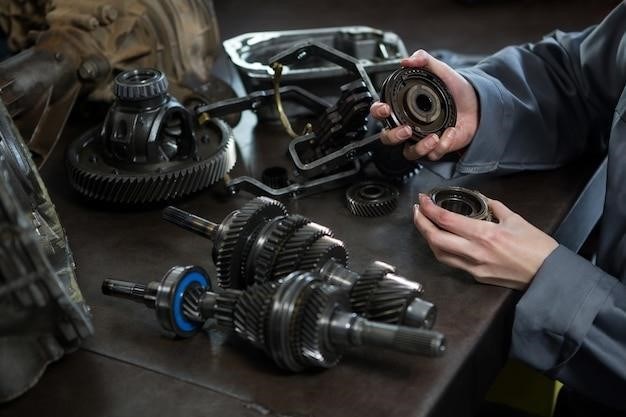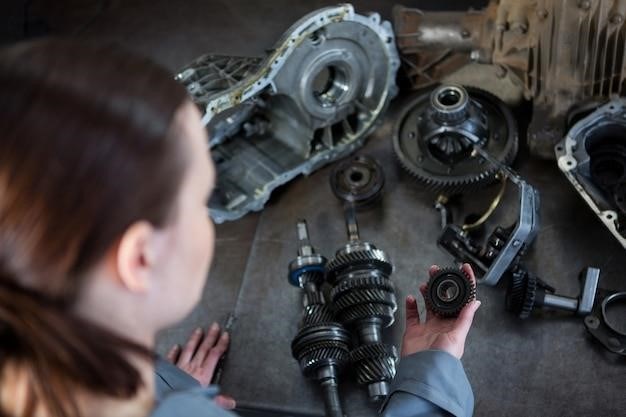manual gearbox problems
- Published
- in Manuals
Manual Gearbox Problems⁚ A Comprehensive Guide
Manual transmissions, while often praised for their engaging driving experience, are not immune to problems. This comprehensive guide will delve into common symptoms, causes, and solutions for manual gearbox issues, helping you understand what to look for and how to address them effectively.
Introduction
The manual gearbox, a mechanical marvel that allows drivers to directly control gear changes, has been a staple in automobiles for decades. While offering a more engaging and often sportier driving experience, manual transmissions are not without their potential pitfalls. Over time, wear and tear, improper maintenance, or even aggressive driving habits can lead to a range of issues that can compromise performance and potentially require costly repairs. Understanding the common symptoms, causes, and solutions for manual gearbox problems is crucial for any owner of a manual transmission vehicle. This guide aims to provide a comprehensive overview of these issues, equipping you with the knowledge to recognize potential problems early, prevent them from escalating, and ensure the smooth operation of your gearbox for years to come.
Common Symptoms of Manual Gearbox Problems
Recognizing the early signs of manual gearbox trouble is essential for preventing more serious issues. These problems often manifest themselves through a variety of noticeable symptoms. One of the most common indicators is a grinding noise when shifting gears. This can occur during gear engagement or when attempting to shift into a specific gear, and is often a sign of worn-out synchros, damaged gears, or insufficient transmission fluid. Difficulty shifting gears, particularly when the transmission is warm, could point to low or degraded transmission fluid, which loses its lubricating properties as it heats up. A feeling of “notching” or a hesitant shift into gear, particularly when transitioning between higher gears, might indicate a problem with the shifter linkage or worn-out components within the gearbox itself. While these are some of the most frequently encountered symptoms, other potential signs include a slipping clutch, a burning smell, or a noticeable leak under the vehicle.
Causes of Manual Gearbox Problems
Manual gearbox issues can arise from a variety of factors, ranging from simple neglect to more complex internal failures. Understanding these causes is crucial for diagnosing and resolving problems effectively. One common cause is clutch problems, which can manifest as slipping, grabbing, or a complete loss of engagement. This can occur due to worn-out clutch plates, a damaged pressure plate, or a faulty hydraulic system. Another contributing factor is transmission fluid issues. Over time, transmission fluid can degrade, losing its ability to lubricate and cool internal components, leading to increased friction, wear, and eventual failure. Internal transmission problems, such as worn-out gears, damaged bearings, or a broken shift fork, can also lead to serious gearbox issues. These problems can arise from a combination of factors, including age, wear and tear, excessive load, or improper maintenance.
Clutch Problems
Clutch problems are a common source of manual gearbox issues, often manifesting as slipping, grabbing, or a complete loss of engagement. The clutch system, responsible for connecting and disconnecting engine power to the transmission, consists of several components that can wear out or fail over time. Worn-out clutch plates, which act as the friction material between the engine and transmission, can cause slipping, making it difficult to accelerate smoothly. A damaged pressure plate, responsible for applying pressure to the clutch plates, can lead to grabbing or a lack of smooth engagement. Faulty hydraulic systems, which control the movement of the clutch pedal, can also cause problems, such as a slow release or a complete loss of engagement. Identifying and addressing clutch problems promptly is crucial to preventing further damage to the transmission and ensuring safe and efficient driving.

Transmission Fluid Issues
Transmission fluid, the lifeblood of a manual gearbox, plays a critical role in lubrication, cooling, and protecting internal components from wear and tear. Over time, transmission fluid can degrade, losing its viscosity and ability to effectively lubricate gears and bearings. This can result in increased friction, leading to harsh shifting, grinding noises, and even internal damage. Low fluid levels, often caused by leaks, can also cause serious problems. Without sufficient lubrication, gears can overheat and wear prematurely. Additionally, contaminated fluid, often due to debris or water ingress, can accelerate wear and compromise the overall performance of the transmission. Regular transmission fluid checks and changes, according to manufacturer recommendations, are essential for maintaining optimal performance and extending the lifespan of your manual gearbox.
Internal Transmission Problems
Internal transmission problems, while often more serious, can manifest in a variety of ways. Worn-out synchros, responsible for synchronizing gear speeds during shifting, can lead to grinding noises, difficulty engaging gears, and even gear slippage. Damaged or worn-out gears, often caused by excessive wear or mishandling, can result in grinding noises, difficulty shifting, and even complete transmission failure. A broken or damaged shift fork, responsible for moving gears into position, can make it impossible to engage certain gears or cause grinding during shifting. Additionally, worn-out or damaged bearings, responsible for supporting rotating components, can lead to excessive noise, vibration, and ultimately, premature wear and tear. Diagnosing internal transmission problems can be challenging, often requiring a professional inspection and potentially, a complete teardown of the transmission. However, identifying the root cause is essential for determining the appropriate repair strategy, ensuring smooth and reliable operation of your manual gearbox.
Diagnosis and Repair
Diagnosing and repairing manual gearbox problems requires a methodical approach. A thorough inspection by a qualified mechanic is crucial. They will assess the vehicle’s history, listen for unusual noises, inspect fluid levels and condition, and test the shifting action. This initial evaluation helps pinpoint the potential source of the issue. Troubleshooting common issues like worn-out clutch components, leaking transmission fluid, or misadjusted linkage is often straightforward, involving replacement or adjustment of the affected parts. More complex internal transmission problems may require a complete teardown for diagnosis and repair, involving the replacement of worn-out or damaged gears, synchros, bearings, or other components. Remember, professional diagnosis and repair are essential for ensuring the longevity and smooth operation of your manual gearbox.
Professional Inspection
A professional inspection is the first step in diagnosing manual gearbox problems. A qualified mechanic will thoroughly examine your vehicle, looking for clues about the issue. They will start by reviewing the vehicle’s history, including any previous repairs or maintenance records. They’ll then listen carefully for any unusual noises during operation, such as grinding, whining, or clunking sounds. The mechanic will also check the transmission fluid level and condition, looking for signs of contamination or low levels. Finally, they will test the shifting action, noting any difficulty, hesitation, or grinding during gear changes. This comprehensive inspection allows the mechanic to pinpoint the potential source of the problem, whether it’s a simple fluid leak, worn-out clutch components, or a more serious internal transmission issue.
Troubleshooting Common Issues
Once a professional inspection has identified potential areas of concern, troubleshooting can begin. This involves systematically examining common issues associated with manual gearbox problems. A mechanic might start by checking the clutch system, ensuring proper engagement and disengagement. They’ll inspect the clutch pedal for free play, the clutch disc for wear or damage, and the hydraulic system for leaks or air bubbles. Next, they’ll assess the shifter linkage, looking for loose or worn components, ensuring smooth and accurate gear selection. The mechanic will also examine the synchronizers within the gearbox, checking for wear or damage that might cause grinding or difficulty shifting. If the problem persists, the mechanic might move on to inspecting the gearbox’s internal components for more serious issues, such as worn gears or broken parts. Through this methodical troubleshooting process, the mechanic can pinpoint the root cause of the gearbox problem and recommend the appropriate repair solution.
Prevention and Maintenance
Just like any mechanical component, a manual gearbox benefits from regular maintenance and responsible driving habits. One crucial aspect is ensuring the transmission fluid is fresh and at the proper level. Old or contaminated fluid can lead to increased friction, wear, and potential damage. Following the manufacturer’s recommended fluid change intervals is essential. Furthermore, adopting responsible driving practices can significantly extend the lifespan of your manual gearbox. Avoid harsh shifting, sudden acceleration, and frequent use of the clutch at high engine speeds. Smooth, controlled gear changes and a gentle approach to driving will minimize stress on the gearbox components. Periodically checking the clutch pedal for free play and ensuring proper adjustment can prevent premature wear. Additionally, regular inspections of the shifter linkage for any signs of looseness or damage are crucial for smooth gear selection. By incorporating these preventative measures and adhering to a regular maintenance schedule, you can significantly reduce the likelihood of encountering manual gearbox problems.
Regular Fluid Changes
Regular fluid changes are essential for maintaining the health of your manual gearbox. Transmission fluid acts as a lubricant, coolant, and cleaner, ensuring smooth gear engagement and protecting the internal components from wear and tear. Over time, the fluid can degrade, losing its viscosity and lubricating properties. This can lead to increased friction, heat buildup, and accelerated wear. While some manufacturers recommend specific change intervals, a general guideline is to replace the transmission fluid every 30,000 to 60,000 miles, depending on driving conditions and the type of fluid used. Regular fluid changes not only help to prevent premature wear but also improve shifting smoothness and overall performance. It’s important to use the correct type of transmission fluid specified by your vehicle’s manufacturer, as using the wrong fluid can damage the gearbox. If you notice any unusual noises or shifting difficulties, it’s advisable to have your transmission fluid checked and replaced if necessary.

Responsible Driving Habits
While regular maintenance is crucial, responsible driving habits play a significant role in extending the life of your manual gearbox. Avoid aggressive driving techniques, such as rapid acceleration and harsh shifting, as these can put undue stress on the transmission components. Similarly, avoid prolonged slipping of the clutch, as this can lead to excessive heat buildup and premature wear. When shifting gears, ensure the engine speed is appropriately matched to the selected gear, avoiding unnecessary strain on the transmission. Smooth and controlled gear changes are essential for minimizing wear and tear. Additionally, avoid driving with a faulty clutch, as this can lead to further damage to the gearbox. A well-maintained clutch and responsible driving practices help ensure that your manual transmission operates smoothly and efficiently for years to come.
Understanding the common symptoms, causes, and solutions for manual gearbox problems empowers you to proactively address any issues that arise. Regular maintenance, including fluid changes and responsible driving habits, are crucial for preventing problems and maximizing the lifespan of your transmission. When faced with a potential issue, a professional inspection is always recommended to diagnose the problem accurately. With timely maintenance and responsible driving, you can enjoy the engaging driving experience of a manual transmission for years to come. Remember, a healthy manual gearbox is not only essential for smooth and efficient operation but also contributes to a more enjoyable driving experience.
